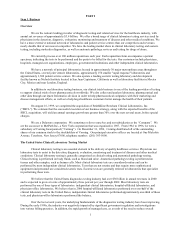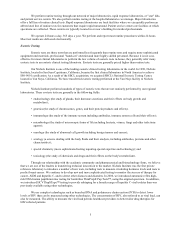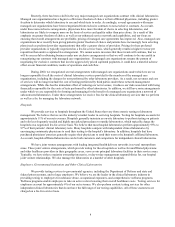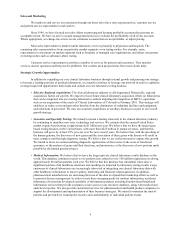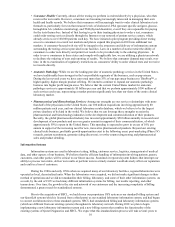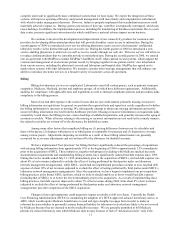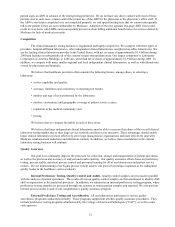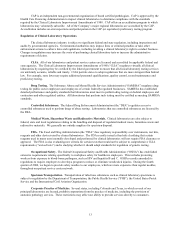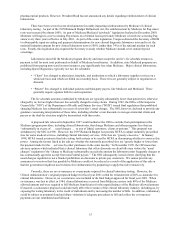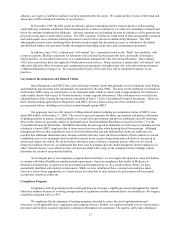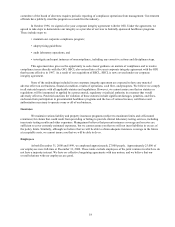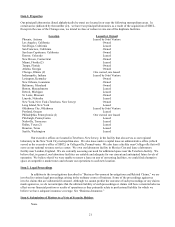Quest Diagnostics 2000 Annual Report Download - page 31
Download and view the complete annual report
Please find page 31 of the 2000 Quest Diagnostics annual report below. You can navigate through the pages in the report by either clicking on the pages listed below, or by using the keyword search tool below to find specific information within the annual report.11
complete and result in significantly more centralized systems than we have today. We expect the integration of these
systems will improve operating efficiency and provide management with more timely and comprehensive information
with which to make management decisions. However, failure to properly implement this standardization process could
materially adversely impact us. During system conversions of this type, workflow is temporarily interrupted, which may
cause backlogs. In addition, the implementation process, including the transferring of databases and master files to a new
data center, presents significant conversion risks which could have a material adverse impact on our business.
We continue to invest in the development and improvement of our connectivity products for customers and
providers by developing differentiated products that will provide friendlier, easier access to information. During the
second quarter of 2000 we introduced a new service offering physicians secure access to their patients' confidential
laboratory results via the Internet through our own web site. During the fourth quarter of 2000 we introduced a new
service enabling physicians to order tests (as well as receive results) through our web site. This new service will allow us
to replace desktop products that we currently provide to most physicians. During the second quarter of 2000, we entered
into an agreement with MedPlus to market MedPlus' ChartMaxx and E. Maxx patient record systems, which support the
creation and management of an electronic patient record, by bringing together in one patient-centric view information
from various sources, including the physician's records and laboratory and hospital data. MedPlus has agreed not to
market these systems with other laboratories. We intend to consider other strategic arrangements that will enhance our
ability to introduce electronic services to a broader variety of customers across all spectrums.
Billing
Billing for laboratory services is complicated. Laboratories must bill various payers, such as patients, insurance
companies, Medicare, Medicaid, doctors and employer groups, all of which have different requirements. Additionally,
auditing for compliance with applicable laws and regulations as well as internal compliance policies and procedures adds
complexity to the billing process.
Most of our bad debt expense is the result of issues that are not credit-related, primarily missing or incorrect
billing information on requisitions. In general, we perform the requested tests and report test results regardless of whether
the billing information is incorrect or missing. We subsequently attempt to obtain any missing information and rectify
incorrect billing information received from the healthcare provider. Missing or incorrect information on requisitions adds
complexity to and slows the billing process, creates backlogs of unbilled requisitions, and generally increases the aging of
accounts receivable. When all issues relating to the missing or incorrect information are not resolved in a timely manner,
the related receivables are written-off to the allowance for doubtful accounts.
Among many other factors that complicate billing are (1) pricing differences between our fee schedules and
those of the payers, (2) disputes with payers as to which party is responsible for payment and (3) disparity in coverage
among various payers. Adjustments impacting receivables as a result of these billing related matters are generally
accounted for as revenue adjustments and not written-off to the allowance for doubtful accounts.
We have implemented “best practices” for billing that have significantly reduced the percentage of requisitions
with missing billing information from approximately 16% at the beginning of 1996 to approximately 5.5% immediately
prior to the acquisition of SBCL. These initiatives, together with progress in dealing with Medicare medical necessity
documentation requirements and standardizing billing systems, have significantly reduced bad debt expense since 1996.
During the twelve months ended July 31, 1999 (immediately prior to the acquisition of SBCL), our bad debt expense was
about 6% of net revenues (adjusted to exclude the effect of testing performed by third parties under our laboratory
network management arrangements), while SBCL, which had not implemented procedures similar to ours, had bad debt
expense of about 10% of net revenues (adjusted to exclude the effect of testing performed by third parties under SBCL’s
laboratory network management arrangements). Since the acquisition, we have begun to implement our pre-acquisition
billing practices at the former SBCL facilities, which we believe should enable us to lower overall bad debt expense
(including that of SBCL) to or below the levels immediately prior to the acquisition. As a result of implementing these
billing practices, bad debt expense improved to about 7% of net revenues during 2000, from about 8% of net revenues
(adjusted to exclude the effect of testing performed by third parties under our laboratory network management
arrangements) just after completion of the SBCL acquisition.
Changes in laws and regulations could negatively impact our ability to bill our clients. Currently the Health
Care Financing Administration (HCFA) is considering the adoption of a HCFA-approved advance beneficiary notice, or
ABN, which would require Medicare beneficiaries to read and sign a lengthy two-page form in order to make an
informed decision whether to personally assume financial liability for laboratory tests which are likely to be not covered
by Medicare because they are deemed to not be medically necessary. We are generally permitted to bill Medicare
patients for clinical laboratory tests which Medicare does not pay because of lack of “medical necessity” only if the


